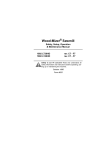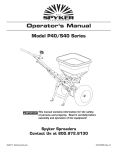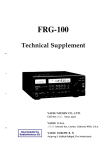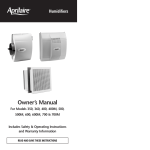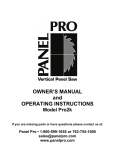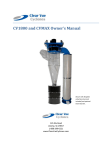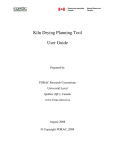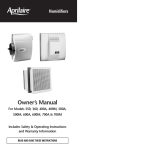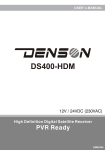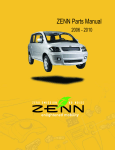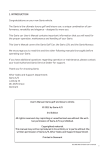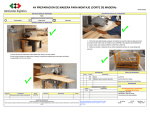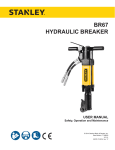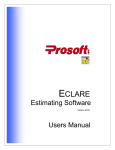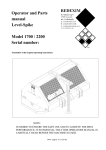Download p10v45 service / repair
Transcript
SERVICE DELTA^Q DELTA^Q DELTA^Q DELTA^Q DELTA^Q DELTA^Q DELTA^Q P10V45 SERIES AXIAL PISTON PUMPS DELTA^Q DELTA^Q Plant Location and Mailing Address 10827 Tower Oaks Blvd Houston, TX 77070 Website: www.deltaq.com Email: [email protected] Phone: (281) 807-1840 or (800) 650-3110 Fax: (281) 807-4457 12-2008 INTRODUCTION This service manual contains procedures for trouble shooting and repairing the DELTA^Q LTD. P10V45 series piston pump. It does not include the controls, see Control Service Manual for that information. It is DELTA^Q LTD. policy to continually upgrade their products. This may from time to time make some of the discussion in the repair manual not agree exactly with the components you are looking at, if a major change had taken place that would be reflected in the Model Number. WARNING! Before breaking a circuit connection, make certain that power is off and system pressure has been released. Lower all cylinders, discharge all accumulators and block any load that might move and generate pressure. PUMP DESCRIPTION: The P10V45 series piston pump is open loop and axial in design. Split flange and SAE O-Ring Ports are available on either side or rear. An SAE “A & B” Mounting pad is available on the rear to drive a small pump. The “P10V45” pump may be driven by any source of power; Diesel, Gasoline, Electric. Plumbing is of the utmost importance to prevent cavitation at the inlet as well as compliance on the outlet. In some applications super-charging the inlet may be required. The pump is rated for 4000 psi therefore the discharge piping must be capable of that pressure. There are a variety of controls available such as pressure compensation, load sense, torque limiter and variations of these. Controls are continually being developed so check with DELTA^Q if a particular control is required. RELATED PUBLICATIONS: Installation dimensions for the “P10V45” series piston pump and controls are not included in this manual. Individual parts numbers are also not included. Refer to the related publications that include this type of information. Sales and Application (includes installation drawings). Theory of Pump operation Theory of Control operation Service Book, pump (this booklet) Service Parts Book, pump Approved Fluids TROUBLE SHOOTING This trouble shooting guide lists common problems encountered with piston pumps in hydraulic systems. It indicates probable cause and remedies for each problem. TROUBLE Excessive noise in pump. PROBABLE CAUSE Low oil level in reservoir Air in the system Inlet restriction Thick oil Cold Weather Pump overheating Internal leakage Heat exchanger not functioning Fluid level low REMEDY Fill reservoir to proper level with recommended fluid. DO NOT OVERFILL 1. Open reservoir cap and operate hydraulic system until purged. 2. “Bleed” hydraulic lines at highest point downstream of pump while system is under pressure. Check inlet (suction) lines and fittings for obstructions and leaks Empty and refill with correct oil Actuate hydraulic system until pump is warm to the touch. If determined that excessive case flow exists then return pump to maintenance shop for overhaul Locate trouble and repair, refer to machine manufacturers guide Add oil to proper level, determine cause System not Compensator malfunctioning Replace adjust or repair developing pressure Loss of fluid High case flow Return to maintenance shop for repair Broken shaft Return to maintenance shop for repair System shut off valves not open Pump rotating in wrong direction Locate and open Failed hydraulic line Leaking pump seals or system seals Correct by changing pump or drive rotation. CAUTION do not run in this configuration or damage will result! Locate and repair Check the O-Ring between mating pump surfaces, shaft seal and system seals, replace. P10V45 SERIES WORK SPECIFICATIONS CAM: NOTE: THE CAM HAS A VERY THIN HARD COAT AND MAY NOT BE REFACED. VALVE PLATE: THICKNESS 0.190 MIN NOTE: WATCH FOR CAVITATION CAUSED EROSION NEXT TO KIDNEYS AND HOLES THIS WILL NOT AFFECT PUMP PERFORMANCE BUT MAY INCREASE NOISE AND REDUCE LIFE. CAVITATION SHOULD NOT BE PRESENT AND THE CAUSE SHOULD BE ELIMINATED. PISTON ASSEMBLIES: SHOE FLANGE THICKNESS SHOE FACE RECESS SHOE TO PISTON END PLAY 0.147 0.010 MIN 0.005 MAX CYLINDER BLOCK: GROOVE DEPTH PISTON BORE DIAMETER 0.020 MIN 0.6705 MAX SHAFT END PLAY: 0.002 TIGHT BEARINGS: INSPECT FOR GALLING AND OR PITTING, IF PRESENT REPLACE. INSPECT CAM BEARINGS FOR SCORING AND WEAR, REPLACE IF PRESENT. ADAPTER BEARING BORE COVER BEARING BORE ASSEMBLY TORQUE: ASSEMBLY BOLTS (4) EARLY DESIGN WITH GASKET ASSEMBLY BOLTS (4) CURRENT DESIGN WITH SEAL CONTROL AND COUNTERBALANCE POST CASE LEAKAGE AT 2500PSI AND 110°F CONTROL SET >3000PSI 2.4404 MAX 1.7805 MAX 75 LB-FT 55 LB-FT 40 LB-FT <0.75 GPM THESE SPECIFICATIONS ARE TO BE USED AS A GUIDE ONLY DISASSEMBLY AXIAL PISTON PUMP KEEP IT CLEAN! The Axial Piston Pump is a precision machine with low tolerance for dirt and contaminants. The real work in overhauling the pump begins before the pump is removed from its application. Use commercial solvent or steam, clean the pump and its fittings. 45.0001 It is a common error to leave a hose open and drop it in the dirt. Granuals of sand and dirt finding a way into the hose will destroy the pump - no matter how clean your disassembly area may be. PLUG THOSE HOSES! 45.0002 Have hose plugs ready so that as each hose is disconnected, it can be immediately sealed against dirt and dust. 45.0003 Similarly, each newly exposed opening and port in the pump should be sealed immediately with a plug. If you have no plastic plugs, use new clean rags - but be careful that cloth fibers are not retained when the rag is removed. 45.0004 Naturally the work area must be clean and well lighted. Do not work on hydraulic pumps in areas near welding operation. The welding “smog” you can see in the air contains abrasives. 45.0005 Do not disassemble a pump outdoors or in other areas open to wind or rapidly moving air which can carry dust or dirt. 45.0006 It is not a good idea to smoke while overhauling the pump - the ash in smoke is abrasive. 45.0007 Some controls have a “Load Sense Pin” be careful not to lose the small piston when the hose is disconnected. This piston has no retainer and is free to fall out on the ground. DO NOT LOSE THIS PISTON! 45.0008 It will be useful to have some small plastic bags handy so that small parts can be stored out of harms way. Also a large plastic (Garbage) bag is ideal for covering the pump overnight if you cannot complete the overhaul in one day. 45.0009 Because the pump is disassembled shaft down, either bore a 1 1/2 inch hole in the work bench or prepare a wooden support block. A support block can be a 2X4X8 inches long. It should have a 1 1/2 inch hole for the shaft, holes for the pump flange and some method of securing the block to the bench top such as a large vise. 45.0010 TOOLS NEEDED TO OVERHAUL THE PUMP Torque Wrench capable of 55 LB-FT. Allen Wrench 1/2“ for pump assembly bolts. Allen Wrench 3/16” for control bolts. Snap Ring Pliers Internal for Seal and Cylinder Block. Soft Faced Hammer for driving the seal. 500 Grit Paper to re-face the Pistons and Cylinder Block and a lapping plate. Tray of Mineral Spirits Solvent. Seal Driver and Thimble to install the Seal. Method to compress the Cylinder Block Spring. Small fixture with three holes to assist installation of Loading Pins. Needle Nose Pliers to install Loading Pins. Arbor Press to install/un-install Shaft Bearings. Round Tube to press bearings so not to damage the cage. 45.0011 Using the wood block previously made, secure the pump to it and then mount the wood block in a large bench vise. Before starting to disassemble mark the relation between the cover and Adapter. This will assure the pump will go back together correctly. 45.0012 Remove the control and note the position of the orifice(s) if present. Note also that the adjustment points to the inlet side. 45.0013 Loosen the four assembly bolts and remove the Cover. With the cover will come the Control Post and C'Balance Post, these post will not have to be removed further unless they are damaged. Note the location of the Control and C'Balance Post relation to the Adapter. 45.0014 Now remove the loose pieces, Valve Plate, Bearing Cone, Bearing Shim, Dowel Pin, Control Piston, C'Balance Piston with Spring and Molded O-Ring. Inspect the bearing for pitting, the pistons for scoring and the valve plate for cavitation and scoring. Replace any of the components that show these signs of damage. 45.0015 Remove the Cylinder Block Assembly. If the Cylinder Block is going to be reused it should be disassembled to clean the spring chamber. The spring chamber is a low pressure area and collects contamination. 45.0016 See the section at the end of the pump disassembly for “Cylinder Block disassembly”. Remove the nine Pistons, Return Plate and Pivot Ring as one unit. Inspect the components for scratches, scoring and wear, replace if needed. Inspect the bronze shoes for wear and rounding, they can be reconditioned. See the Work Specification page at the beginning of this book. 45.0017 Remove the Cam and Shaft(with bearing cone) by grasping the end of the shaft and lift straight out. Note the end of the Cam with two holes position relative to the Adapter, mark the Adapter so it will go back in the same position. Inspect the Cam face and journals for wear and scoring. The Cam face and journals have a thin hard surface and cannot be reconditioned, replace if worn or scored. 45.0018 Inspect the bearing for pitting and replace if found. Inspect the shaft for wear where the seal runs, replace shaft if it is grooved. Inspect the face of the pivot shoes and re face if needed. Remove the two Cam Bearing Halves, noting how the anti-rotation tabs fit. Inspect the surface of the bearings for scoring, they can be refaced with 500 grit paper. 45.0019 Turn the Adapter upside down, with a suitable tool, remove the seal Retaining Ring. 45.0050 Using a round bar (1 1/2 inch diameter) and a Rubber Hammer drive the Seal inward until it is free. 45.0021 IF THE CONTROL OR C'BALANCE POST IS DAMAGED IT MUST BE REPLACED They are both held in place with Loc-Tite 242 on the threads, apply considerable CCW torque to remove. Note, the position of each relative to the Port Cover and note there are no O-Rings. 45.0022 THE CYLINDER BLOCK SHOULD ALWAYS BE DISASSEMBLED AND CLEANED A tool like this can be made from a 1/2 x 3 inch bolt, two nuts and a washer (OD=1.21) with a flat ground on the washer to clear the retaining ring ears to compress the spring. Or you can make one as shown as TL008 in the tool section of this book. 45.0023 CYLINDER BLOCK DISASSEMBLY: CAUTION! spring is under compression use care when removing. With a tool to compress the spring, snap ring pliers (with the nose bent 90°) and an arbor press, compress the spring just enough to remove the retaining ring, do not over compress the spring. 45.0024 Pump Assembly Keep it clean Gather all the parts be sure they are clean. Coat all rubbing parts such as Pistons, Cylinder Block, Spools, Cam, and Valve Plate with 10W oil. 45.0025 45.0026 Set up the adapter on a suitable base. Be sure to note the location of the case drain ports Install the two 1/4“ roll pins(if they were removed) in the top of the adapter. They can be driven in with a hammer. CASE DRAIN CASE DRAIN Press in the shaft bearing cup using a suitable tool that allows bearing cup to seat against adapter bore. 45.0027 Press the shaft bearing cone onto the shaft with a suitable tool. Pay attention to the roller cage so it is not crushed during assembly. The diameter of the pushing tool needs to be smaller than the inside diameter of the cage. See TL005/TL006 and TL004 in the tool section of this book. 45.0028 If any of these components have been replaced the bearing pre-load must be checked: SHAFT PORT COVER ADAPTER SHAFT BEARINGS Required pre-load is 0.002/0.003 Inch. Using a base shim of 0.080 and a dial indicater load the shaft up and down while rotating, read the maximum movement. Add that amount to the 0.080 shim plus required preload and grind a new shim to obtain. Note required shim thickness for later use. 45.0029 Install the Cam Bearings making sure the anti rotation tabs are positioned correctly in the recess. Install the shaft with bearing cone. 45.0030 Install the cam assembly paying attention to which end has the two holes (this is the Counter Balance end). The orientation of the cam should have been noted at disassembly. 45.0031 Lubricate the two journals with petroleum grease before installing. WITH CASE DRAIN HERE Make a tool to hold the three loading pins as shown here. Slide this fixture into the spline from the neck end of the cylinder block not the inside. This is not the only way to install the pins, use what ever method works. TL009 45.0032 Install the three loading pins with a needle nose plier as shown, rotate each pin so the lip on the pin is outward. 45.0033 Now install the washer (there is only one) onto the loading pins. Be sure the Washer OD fits inside the three tabs on the Loading Pins. 45.0034 Place the spring on top of the washer just installed. Using a tool that will allow you to compress the spring (can be made from a bolt two nuts and a washer). Compress the spring just far enough to install the retaining ring, depressing it more will over stress the spring. 45.0024 Assemble the rotating group as shown. Lubricate the pieces with 10W oil before assembling. 45.0036 Using a device such as an O-Ring, wrap it around the pistons, this will hold the assembly together while it is installed into the adapter. 45.0037 Turn the rotating group upside down and lower it into the adapter, rotate it slightly to align the splines in the shaft with the splines in the cylinder block and pivot ring. 45.0038 Now that the rotating group is assembled install the Molded O-Ring to the top of the adapter, lubricate the O-Ring first to hold it in place. Install the Bearing Shim and Cone onto the Shaft. Install the C'balance Post and Control Post. Note the position of each, the Control Post must be in the hole next to the Control. Apply Loc-Tite 242 (Blue) to the threads before installing, torque to 40 LB-FT. 45.0039 C'BALANCE POST 45.0040 CONTROL POST Note: these post do not require O-Rings. Press the bearing cup into the port cover. 45.0041 Install the dowel pin next to the Control Post. 45.0042 Lubricate the underside of the Valve Plate with petroleum jelly, this will keep it in place while the cover is assembled. Assemble the Valve Plate to the Cover being sure it sits flat on the Cover. 45.0043 Install the Spring onto the C'Balance Piston, lubricate the C'Balance Piston and Control Piston with 10W oil or Petroleum Jelly and install in/on their posts. 45.0044 Note: If there was a stroke spacer it should be installed under the Control Piston here. Grasping the Cover assembly using your fingers to hold the C'Balance and Control Pistons in place install it onto the Adapter assembly noting the position of the C'Balance Post. The C'Balance Piston with the Spring should reside on the same side of the cam that has the two external holes discussed earlier. 45.0045 Install the four 7/16 bolts with lockwashers. Torque the bolts evenly to 55LB-FT. 45.0046 Turn the assembly onto it's cover. Lubricate the seal inside and out with petroleum jelly. Using a seal thimble, install the seal. The seal can be installed without a thimble but the shaft would need to be buffed at the leading chamfer with 600 grit paper before the shaft was assembled if not the seal could be cut at assembly. 45.0047 45.0048 Install with open end of Seal towards pump. Drive the seal in place with a seal driver, do not drive too hard there is no stop and the seal will be driven in to far. 45.0049 Install the seal retaining ring. 45.0050 Prepare to install the control, shown are two configurations, there are many. Note the positions of any external orifices and return them to their original locations. Not all controls have orifices. 45.0051 The control adjustments should point to the inlet side of the pump. Install the four 1/4“ bolts, not all will have lockwashers. Torque to 10 FT-LBS. 45.0052 The pump is now ready to re-install. 45.0053 Application Notes, Piston Pumps Filtration Inlet • Use 100 mesh screen. • Inlet filters are not recommended except for super charged systems. Outlet • Filters, either pressure-line or return, should be capable of keeping fluid cleanliness as follows: Operating Pressure ISO Cleanliness <2000 PSI 18/16/14 2000 to 3000 PSI 17/15/13 >3000 PSI 16/14/12 Inlet Conditions • Check pumps drive speed against required inlet pressure. • Make adjustments for altitude if necessary. • Install pump below reservoir to assure flooded inlet when possible. • If necessary install charge pump on auxiliary pad (SAE 'A' or 'B'). • Conditions must be met at lowest operating temperatures. Case Pressure “IMPORTANT” • Use one case drain per pump, ½ inch dia. Minimum. • Do not use filters or coolers in case drain lines. • Case pressure must not exceed 7 PSI above inlet pressure (Example: If inlet pressure is 10 PSI, case pressure must not exceed 17 PSI). • 25 PSI maximum case pressure. • Use upper most case drain port. • Connect case drain below fluid level in side of reservoir. • Run case lines in such a manner to prevent draining, siphoning or air locking of fluid. Compensator setting • Compensator settings are factory set but may be field adjusted. • If adjustments are necessary CW rotation will increase setting; CCW rotation will decrease setting. Load Sense Lines • Use of ¼“ O.D. steel or steel-braid load-sense lines may be required for stability if distance from pump to control valve is excessive. • On load-sense controls, sense line must be connected to pressure for high-pressure cut-off to occur. For low-pressure standby the sense line must be vented to tank unless dynamic load-sense pin is used then line may be blocked. Start-Up • Install required gages prior to filling pump with fluid to observe case pressure, system pressure and inlet pressure to make sure it is within DELTA^Q ratings. • Check all fittings to be sure they are tight. • Fill reservoir with filtered approved oil. • Fill pump case with filtered system oil. Make sure case is at least half full before start-up. Internal leak age will not provide enough lubrication if case is dry. Pump must not run dry. • Open any shut off valves between reservoir and pump. • If the pump is used in a closed outlet system, discon nect the outlet line until pump is primed and pumping fluid. Pump must not be allowed to pump into a closed system application until the pump has primed or damage to the pump will occur. • Start prime mover and operate at minimum speed and minimum pressure until all air is purged from the pump. Stop the prime mover and reconnect pump outlet hose then purge air from the system by starting the prime mover and operating control valve. • Check fluid lines for leaks. Inlet line must be “air tight”. • Re-check reservoir fluid level, add if necessary. • Cycle pump observe system pressure, case pressure and inlet pressure to ensure that they fall within the pump rating. Pump Rotation • Can be changed by installing opposite rotation cover and valve plate. Application Assistance • Professional application and controls engineering assistance is available. • Complete the pump application form and contact DELTA^Q. ! WARNING • Failure to comply with any of these requirements and procedures will result in a voided warranty























